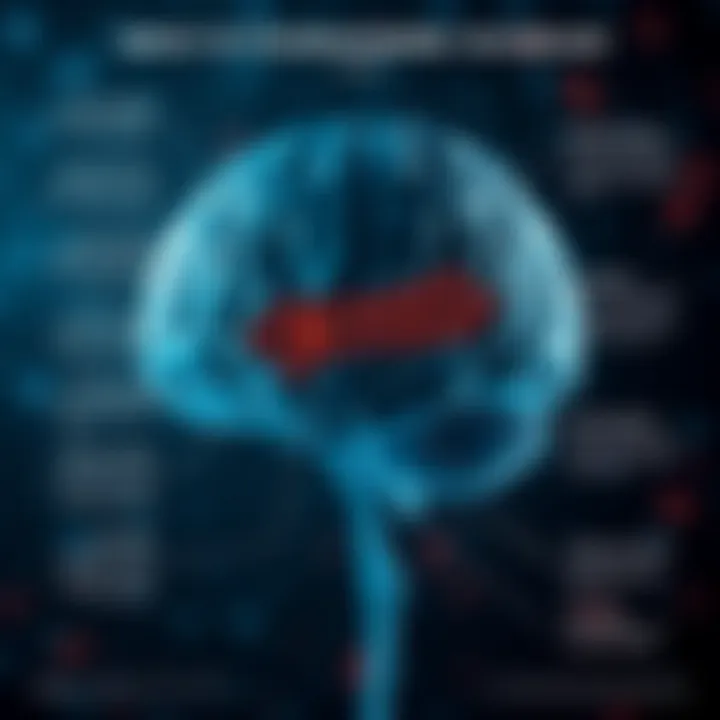Exploring the Complexities of the Brain Barrier


Overview of Research Topic
Brief Background and Context
The brain barrier is an intricate structure that plays a pivotal role in maintaining the delicate environment of the central nervous system (CNS). Of critical importance, the blood-brain barrier (BBB) selectively permits substances to pass from the bloodstream into brain tissue while keeping potentially harmful agents at bay. Its existence is both a blessing and a curse: it defends the brain against pathogens and toxic compounds but also complicates the delivery of therapeutics intended for neurodegenerative diseases and other neurological disorders. The brain barrier is not a solitary entity; instead, it encompasses a complex network of cells, including endothelial cells, astrocytes, and pericytes. This multifaceted arrangement presents an intriguing area of study for scientists who seek to untangle the mysteries behind its function and significance.
Importance in Current Scientific Landscape
In the present scientific landscape, understanding the brain barrier is imperative for several reasons. First and foremost, the innovations in neuroscience are underpinned by the ongoing need to decipher how this barrier influences neurobiology, especially in conditions like Alzheimer's and multiple sclerosis. Key research has increasingly focused on its role as a potential therapeutic target — a veritable gateway that could either hinder or help the treatment of various CNS conditions. With advancements in imaging technology and molecular biology, researchers are now able to explore pathways that were previously considered impenetrable, leading to novel therapeutic avenues that may alter the treatment landscape for neurodegenerative diseases. Moreover, the implications of the brain barrier extend beyond clinical applications to influence fundamental research in neurodevelopment and neuroinflammation.
Methodology
Research Design and Approach
To comprehensively explore the intricacies of the brain barrier, this article synthesizes findings from both experimental studies and clinical trials. A thorough literature review was conducted, focusing on peer-reviewed journals, government publications, and academic theses that discuss the structure, function, and implications of the brain barrier. This systematic approach enables the integration of diverse perspectives and methodologies, enriching the overall understanding of the subject.
Data Collection Techniques
Data collection involved analyzing a variety of sources:
- In vivo studies showcasing physiological responses to barrier disruption.
- In vitro experiments to examine cellular interactions within the barrier.
- Imaging techniques such as MRI and PET scans employed to visualize the BBB in real-time.
- Clinical data obtained from trials investigating treatments for neurological disorders.
The range of data collection techniques allows for a holistic view of how the brain barrier operates within both healthy and diseased states. This melding of methodologies not only bolsters the credibility of the conclusions drawn but also highlights the multifaceted nature of the brain barrier as it relates to health and disease.
"The brain barrier is like a fortress: crucial for safeguarding the brain, yet tricky when it comes to delivering essential treatment."
As we delve deeper into this exploration, it’s vital to understand how these barriers inform our knowledge of brain health and the strategies being developed to overcome its challenges. For more detailed discussions and findings on this topic, visit Wikipedia on Blood-Brain Barrier or Britannica's coverage on Brain Barrier for foundational insights.
Preamble to the Brain Barrier
The topic of the brain barrier stands as a cornerstone of neurobiology and overall health. It’s not just a protective layer; it’s a vigilant gatekeeper, playing a monumental role in how our brains interact with the world. This section takes a closer look at the significance and foundation of this topic, laying the groundwork for deeper explorations.
Definition and Importance
At its core, the brain barrier, predominantly the blood-brain barrier, is a selective permeability mechanism that safeguards the central nervous system. It allows essential nutrients in while keeping out potentially harmful substances. Imagine it as a bouncer at an exclusive club; only those who meet certain criteria are allowed in. This filtration system is vital not only for maintaining the equilibrium within the brain but also for sustaining neurochemical balance. By preventing toxins and pathogens from entering brain tissue, the barrier helps protect cognitive functions.
Furthermore, disruptions in this barrier can lead to dire consequences, such as neurodegenerative diseases or other neurological disorders. The understanding of this system can bolster the development of targeted therapies aimed at alleviating these conditions.
"The brain barrier is a formidable protector, but its breaches can lead to profound disturbances in neurological health."
In short, comprehension of the brain barrier’s role is indispensable for students, researchers, and practitioners who aim to navigate the intricacies of human health.
Historical Context
Historically, the concept of the brain barrier was not always clear. Early anatomists wrote about the brain's protective structures, but it wasn’t until the 20th century that significant progress was made.
Initial observations around the turn of the century hinted at a mysterious separation of the brain from the bloodstream. In the 1960s, the electron microscope allowed scientists like Reese and Karnovsky to visualize the intricate cellular structures involved in the barrier’s formation. Their work sparked further inquiry, paving the way for understanding how this barrier influences both neurologic health and disease processes.
In the years that followed, the significance of the brain barrier became increasingly evident, especially in the context of neurological disorders like Alzheimer’s and multiple sclerosis. These insights led to a surge in research aimed at uncovering how the brain barrier could be leveraged in therapeutic settings.
This historical lens reveals not just how far our understanding has come but also the pressing need for continuous research. The pursuit of knowledge concerning the brain barrier remains an ever-evolving journey, pivotal to both basic and applied neuroscience.
Anatomical Structure of the Brain Barrier
The anatomical structure of the brain barrier is not just a detail in neuroscience but a pivotal component that holds significant weight in understanding the complexities of neurobiology. This section delves into how the brain barrier is constructed and its essential role in maintaining homeostasis within the central nervous system. With increasing research pointing toward its implications in various diseases, understanding its intricate architecture can illuminate pathways toward innovative therapies.
Components of the Blood-Brain Barrier
At the heart of this barrier lies the blood-brain barrier (BBB), a selectively permeable gatekeeper composed primarily of specialized endothelial cells that line the brain's capillaries. These cells are distinct from those found in the rest of the body. They are tightly packed together, forming what is known as tight junctions. This unique formation restricts the movement of substances, providing a controlled environment for the brain. Here are some key elements:
- Endothelial Cells: As the building blocks of the BBB, these cells ensure that only certain substances can pass into the brain. Unlike the endothelial cells in peripheral blood vessels, those in the BBB have fewer pores, contributing to its protective nature.
- Astrocytes: These star-shaped glial cells are more than just brain fillers; they provide crucial support to the endothelial cells. Astrocytic end-feet envelop the capillaries, playing a direct role in the regulation of nutrient flow and waste removal.
- Pericytes: Embedded within the walls of capillaries, pericytes contribute to the stabilization of blood vessels. Their role also extends to modulation of blood flow and inflammatory response, making them vital for barrier integrity.
- Extracellular Matrix: This network of proteins and carbohydrates surrounds the cells, providing structural support and influencing cellular behavior. It functions as a scaffold that ensures proper communication between cells, an essential aspect of maintaining barrier functionality.


The blood-brain barrier operates not just as a wall but as a dynamic interface – a sophisticated interplay of cellular components ensuring the brain is well-protected from toxins and pathogens while allowing essential nutrients to flow.
Physiological Characteristics
The physiological characteristics of the brain barrier underscore its complexity and adaptability. At its core, the BBB is governed by several key features that allow it to function effectively in a constantly changing environment:
- Selective Permeability: This intricate barrier selects what enters the brain, permitting essential molecules like glucose and oxygen while denying the passage of harmful substances. This selectivity is a critical feature that prevents neurotoxicity and promotes overall brain health.
- Active Transport Mechanisms: The brain barrier employs various transport proteins to facilitate the movement of crucial nutrients. This active transport ensures that even in times of scarcity, the brain receives its required sustenance.
- Dynamic Nature: The BBB is not static; it responds to physiological changes such as inflammation or injury. This responsiveness can lead to alterations in permeability, allowing therapeutic agents to enter the brain or responding to pathogens when necessary.
- Regulatory Factors: Multiple signaling pathways influence the barrier's functionality. Cytokines and growth factors play a role in modifying the barrier's permeability, which can have implications for both health and disease states.
Understanding the components and physiological characteristics of the brain barrier is vital, as it lays the groundwork for future research and therapeutic approaches. As scientists delve deeper, the nuances of these structures will surely spill into practical applications, potentially revolutionizing treatment for neurodegenerative diseases and traumatic brain injury.
For further reading about the structure and functions of the blood-brain barrier, you may visit Wikipedia or consult resources available at Britannica and PubMed.
Functions of the Brain Barrier
The brain barrier, primarily the blood-brain barrier (BBB), plays an essential role in maintaining the homeostasis of the central nervous system. It functions as a selective gatekeeper, allowing certain substances to pass while repelling others, thus safeguarding the brain from potential harm. Understanding the functions of the brain barrier is pivotal, not only for comprehending basic neurobiology, but also for grasping how various diseases manipulate these pathways to their advantage. This section will delve into three critical functions: selective permeability, protection against pathogens, and the impact on neurotransmitter regulation.
Selective Permeability
The most notable feature of the blood-brain barrier is its selective permeability. This characteristic ensures that only specific molecules can enter the brain while excluding harmful substances like toxins and pathogens. The endothelial cells that make up this barrier are tightly packed together, a design choice that prevents most substances from slipping through.
- Nutrient Transport: Essential nutrients like glucose and amino acids are actively transported across this barrier. These transport mechanisms are crucial because, while the brain is only 2% of body weight, it consumes a staggering 20% of the body's energy.
- Ion Regulation: The BBB also plays a significant role in maintaining the ion balance essential for neuronal function. By regulating ions like potassium and sodium, it contributes to the electrical stability necessary for effective communication between neurons.
In light of these factors, the selective permeability of the brain barrier is not a mere protective feature; it's a complex regulatory system vital for neuronal health and function.
Protection Against Pathogens
Another vital function of the blood-brain barrier is its role in protecting the brain from pathogens such as bacteria, viruses, and fungi. The barrier acts as the brain's first line of defense, helping to prevent infections that could lead to conditions like meningitis or encephalitis.
- Immunological Surveillance: While the BBB is a formidable barrier, it doesn't stand alone. It works in tandem with the immune system. Microglia, the resident immune cells of the brain, constantly monitor for potential threats. They can utilize the BBB's openings to access needed areas, effectively performing surveillance against pathogens without compromising the entire barrier.
- Cytokine Inhibition: Some studies have indicated that inflammatory cytokines can disrupt the integrity of the BBB. This disruption may enable pathogens to enter the brain, leading to inflammation and diseases. Therefore, understanding how the BBB can be compromised, helps inform strategies to bolster its protective capabilities.
By analyzing its protective properties, one can appreciate the intricate balance the BBB maintains, acting firmly but judiciously to protect the brain while also permitting essential access to needed immune functions.
Impact on Neurotransmitter Regulation
The brain barrier also significantly influences neurotransmitter regulation, a cornerstone of neuronal communication. The concentrations of neurotransmitters must be tightly controlled, as fluctuations can lead to various conditions, ranging from mood disorders to neurodegenerative diseases.
- Transport Mechanisms: The BBB selectively allows the transport of neurotransmitters, ensuring they remain at optimal levels in the extracellular fluid. For instance, glutamate, an excitatory neurotransmitter, is continually monitored and cleared by astrocytes connected to the BBB.
- Implications for Mental Health: Recent research suggests that alterations in the BBB may contribute to mental health disorders. If the barrier becomes permeable or dysfunctional, neurotransmitter levels may skew, leading to situations where the brain can become overstimulated or insufficiently activated.
Understanding these dynamics broadens the perspective on neurobiological function and hints at new avenues for treatment, particularly in mental health and neurodegenerative conditions.
A well-functioning brain barrier is crucial for both physical and mental health, as it tightly regulates the environment required for optimal neuronal function.
In future research, exploring the roles of these functions will not only further illuminate our understanding of the brain but may also lend insight into novel therapeutic strategies for diseases that compromise this critical structure.
Brain Barrier and Neurodegenerative Diseases
Neurodegenerative diseases have garnered significant attention over the years, not just because of their immense impact on individual lives, but also due to their implications for public health. Within this context, the brain barrier becomes a critical player. The blood-brain barrier (BBB) functions as a gatekeeper, selectively allowing passage of substances in and out of the brain, which can either support or thwart neuronal health. When discussing neurodegenerative diseases—like Alzheimer's and multiple sclerosis—it’s essential to understand how the integrity of this barrier affects disease progression and treatment options.
This section delves into two prominent neurodegenerative conditions and their interactions with the blood-brain barrier.
Alzheimer's Disease and the Blood-Brain Barrier
Alzheimer's disease is notoriously complex, manifesting in cognitive decline and behavioral alterations that often devastate patients and their families. Research suggests that compromised integrity of the blood-brain barrier can be a contributor to the disease's onset. One key aspect is its role in inflammation. When the barrier becomes leaky, inflammatory agents and potentially toxic molecules enter the brain, escalating neuronal damage.
In early studies, a notable observation was that the BBB in Alzheimer's patients often displayed changes in tight junction proteins, leading to increased permeability. This disintegration can lead to the accumulation of amyloid-beta peptides, which are harmful aggregates often correlated with Alzheimer’s pathology.
Moreover, targeting the blood-brain barrier has been an avenue of immense interest for therapeutic approaches. Novel strategies such as nanoparticles aim to deliver drugs directly to the brain, bypassing a dysfunctional BBB. However, effective methods to restore barrier function without triggering adverse effects remain a significant challenge in the realm of Alzheimer’s research.
"A long-held notion in neurobiology is that the barrier protects the brain, but in Alzheimer’s, its dysfunction makes the brain more vulnerable to damage."
Multiple Sclerosis and Barrier Disruption
Multiple sclerosis (MS) presents another critical case study in the interaction between neurodegeneration and the blood-brain barrier. MS is characterized by autoimmune attacks on the central nervous system, leading to damage in myelin sheaths surrounding neurons. One of the hallmark features of MS is the breakdown of the blood-brain barrier.


In patients suffering from MS, it has been noted that inflammatory cells can penetrate the normally impenetrable barrier. This disruption not only exacerbates neurological deficits but can also lead to irreversible neuronal loss over time.
Studies emphasize the need for early intervention and monitoring of BBB integrity in MS patients. Treatments such as interferon-beta have not only shown to mitigate symptoms but also possess immunomodulatory effects that might help to stabilize the barrier. This area presents fertile ground for future research, as understanding how to fortify the blood-brain barrier in MS could lead to preservation of neurological function and quality of life for millions.
In summary, both Alzheimer's disease and multiple sclerosis showcase the critical nature of the brain barrier in neurodegenerative conditions. The barrier's integrity directly influences disease progression and response to treatment, shining a light on the importance of continued research in this domain.
For further reading on brain health and neurodegenerative diseases, you may check:
- Wikipedia on Blood-Brain Barrier
- Mayo Clinic on Alzheimer’s Disease
- National Multiple Sclerosis Society
- Nature Review Articles
Emerging Research and Therapeutic Approaches
As the complexities of the brain barrier become clearer, the quest for effective therapeutic methods continues to gather momentum. Research in this area is vital, as it opens new avenues for treating various neurological disorders. This section discusses two promising approaches: nanotechnology and biological modulators, both of which offer potential solutions to penetrate the enigmatic barrier that protects the brain while ensuring safety and efficacy.
Nanotechnology in Targeted Delivery
Nanotechnology has emerged as a game-changer in the realm of drug delivery systems. Utilizing materials at the nanoscale, scientists are able to create carriers that can transport drugs directly to the site of action in the brain. This is crucial especially when dealing with conditions like glioblastoma or Alzheimer's disease where medication needs to act precisely and rapidly.
The significance of this approach is multifaceted:
- Enhanced Penetration: Nanoparticles can be engineered to cross the blood-brain barrier more easily than traditional drugs.
- Targeted Delivery: They can be designed to release their payload directly at the affected cells, minimizing side effects and maximizing therapeutic effects.
- Biocompatibility: Many nanoparticles are made from materials that the body can tolerate, reducing adverse reactions.
For example, a certain type of lipid nanoparticle has shown promise in delivering RNA-based therapies, with studies demonstrating enhanced uptake in neural tissues. The precision that nanotechnology affords not only represents a leap forward but also indicates a shift in how we approach treatments for complex diseases.
"The potential of nanotechnology in medicine is only just beginning to be tapped, and its implications for neurological disorders are remarkable."
Biological Modulators
Biological modulators refer to agents that can modify biological processes in a wide range of ways. In relation to the brain barrier, these include various proteins and genes that can alter the permeability of the barrier itself, often acting as gatekeepers.
The exploration of biological modulators comes with a unique set of advantages:
- Natural Mechanisms: Utilizing the body's own pathways may lead to fewer side effects.
- Customized Therapies: Individual responses can be monitored, allowing for adjustments that enhance effectiveness.
- Potential to Repair: Some biological modulators may even aid in repairing damage caused by diseases affecting the barrier.
Research is being conducted into factors like insulin and other growth factors that may enhance the transport mechanisms within the barrier. By manipulating these biological activities, scientists hope to devise treatments that not only address symptoms but potentially halt the progress of neurodegenerative diseases.
The landscape is evolving rapidly, and the confluence of nanotechnology and biological modulators may eventually create a holistic approach to addressing once insurmountable challenges posed by the brain barrier.
Challenges in Brain Barrier Research
Researching the brain barrier presents a multitude of challenges that researchers must navigate to unlock its secrets. Understanding these hurdles is critical, as they not only shape the direction of current studies but also herald future innovations in medical science. Within this section, we’ll delve into the factors influencing the research on the blood-brain barrier, identify specific elements that present difficulties, and weigh the benefits that could stem from overcoming these obstacles.
Modeling the Blood-Brain Barrier
One of the most significant hurdles in brain barrier research is effectively modeling the blood-brain barrier itself. Traditional methods for studying other biological barriers often fall short when applied to the complexities of the brain. Current in vitro models, while helpful, may not completely replicate the intricate cellular environments found within the living organism.
- In Vivo vs In Vitro:
- Many models utilize animal subjects; however, these studies can be limited by species differences in barrier function.
- In vitro models cannot fully account for the dynamic nature of blood flow and biological signaling in the nervous system.
Researchers are increasingly turning towards innovative methods such as microfluidics or organ-on-a-chip technologies to simulate the functionality of the blood-brain barrier. Such advancements promise a higher fidelity representation of physiological conditions. However, these cutting-edge technologies also come with their own set of challenges, including high costs and the need for specialized knowledge in creating and using these setups.
"The intricacies of the blood-brain barrier require a fine balance between precise modeling and biological relevance. Without accurate models, breakthroughs may remain elusive."
Ethical Considerations in Research
Alongside technical challenges, ethical considerations emerge as a focal point in brain barrier studies. Research that involves live animals raises pressing ethical concerns, highlighting the necessity for alternative strategies to ensure humane practices. Scientists are confronted with the challenge of adhering to ethical standards while also pushing the boundaries of knowledge.
Some critical ethical factors include:
- Animal Welfare: Ensuring that animal models are treated humanely while still providing valuable insights.
- Research Transparency: Transparency with research methods and findings encourages trust in scientific advancements. Researchers must carefully communicate both the risks and benefits of their work.
- Societal Impact: The potential implications of their findings, especially concerning therapies for neurodegenerative diseases, necessitate a careful consideration of how these discoveries might affect the broader community.


Careful adherence to ethical guidelines, alongside innovative methodologies, highlights a forward-thinking approach that is vital as researchers attempt to bridge the gap between biological modeling and ethical responsibility.
In summary, challenges in brain barrier research are manifold. From modeling the intricacies of the blood-brain barrier to grappling with the ethical dimensions of such research, these challenges necessitate a thoughtful approach that values both scientific exploration and societal responsibility. Addressing these challenges will undoubtedly pave the road for transformative discoveries in neurology and beyond.
For further reading and resources, you might explore:
- National Institutes of Health (nih.gov)
- PubMed Central (pmc.nih.gov)
- ScienceDirect (sciencedirect.com)
- British Journal of Pharmacology
Future Directions in Brain Barrier Studies
The exploration of the brain barrier remains one of the frontier areas in neurosciences and medical research. Understanding its complexities can significantly influence the development of new treatments for various neurological conditions. As we venture into the future of brain barrier studies, several pivotal themes emerge, offering pathways for interdisciplinary research, innovative technologies, and novel methodologies. Each of these elements holds the potential to reshape how we approach brain health and disease.
Interdisciplinary Approaches
The brain barrier integrates various biological systems, making it essential to adopt interdisciplinary approaches for its study. Collaborations among neurobiologists, pharmacologists, bioengineers, and computational scientists could expedite discoveries that a single discipline might overlook. Here are some aspects to consider:
- Convergence of Knowledge: By combining insights from different fields, researchers can generate comprehensive models that simulate the brain barrier’s behavior under varying conditions.
- Shared Resources: Interdisciplinary teams can share tools and methods that enhance research efficiency. For instance, imaging technologies from bioengineering can aid in observing the barrier's integrity in real-time.
- Broader Perspectives: Diverse expertise allows for a more nuanced understanding of how systemic diseases, like diabetes or hypertension, affect barrier functionality. This interconnectedness can lead to targeted interventions aimed at restoring barrier integrity.
When professionals from different backgrounds come together, they can cultivate a culture of innovation. As an example, work done in the field of nanotechnology interspersed with neuroscience has led to promising avenues for drug delivery across the blood-brain barrier. Collaboration, therefore, is not just beneficial; it is necessary for advancing our understanding of this critical component of human health.
Innovative Technologies and Methodologies
Technological advancements are pushing the envelope of how we study the brain barrier. Modern innovations stand to redefine established methodologies and yield promising new research perspectives. Consider the following technologies:
- In Vitro Models: Developments in creating better in vitro models have made it easier for researchers to mimic the blood-brain barrier in laboratory settings. Using stem cell-derived endothelial cells, scientists can better reflect the biochemical properties of the barrier, enabling detailed genetic studies.
- Advanced Imaging Techniques: Non-invasive imaging tools such as MRI and PET scans can track the functionality of the blood-brain barrier in live subjects. This capability could revolutionize our understanding of how and when the barrier becomes compromised in diseases like Alzheimer's.
- CRISPR and Gene Editing: Gene-editing technologies like CRISPR offer unprecedented opportunities to manipulate pathways related to the brain barrier. The potential to correct genetic predispositions that impact barrier integrity could lead to groundbreaking preventive strategies against neurological disorders.
The future of brain barrier studies is limited only by our imagination and collaboration across diverse scientific disciplines. By leveraging innovative technologies, we can clear the fog surrounding this essential brain defense.
In summary, the horizon of brain barrier research is bright with possibilities. As we blend various fields of expertise and embrace cutting-edge technologies, our understanding of the brain’s protective capabilities will surely evolve. This evolution is not merely a scholarly pursuit; it has real-world implications that touch the lives of many affected by neurological diseases and disorders.
Ending
The conclusion serves as a pivotal element in wrapping up the exploration of the brain barrier, effectively synthesizing key points and highlighting its significance. Throughout the article, we have established that the brain barrier is not just a physical structure but a dynamic participant in maintaining the homeostasis of the central nervous system. Its ability to selectively allow essential nutrients and molecules while blocking harmful substances is crucial for optimal brain function.
Summation of Findings
In essence, our investigation covered multiple aspects of the brain barrier, from its anatomical makeup to its critical role in neurodegenerative diseases. We saw that:
- Selective Permeability: This characteristic is fundamental for protecting the brain without hindering necessary metabolic processes. The barrier functions as a gatekeeper, ensuring that vital compounds traverse while potential toxins remain at bay.
- Protection Against Pathogens: A key function involves defending the central nervous system from infectious agents. The structure's design helps prevent pathogens from breaching, thus protecting delicate neural tissues.
- Impact on Neurotransmitter Regulation: The brain barrier plays a role in neurotransmitter homeostasis, influencing overall cognitive and emotional well-being.
These findings collectively illustrate the brain barrier's critical nature, emphasizing its role in not just safeguarding the brain, but also its participation in various neurological disorders.
Implications for Future Research
Looking ahead, the implications of our insights into the brain barrier cannot be overstated. As research progresses, new methodologies and technologies, such as:
- Nanotechnology: This technology holds promise in enhancing drug delivery across the blood-brain barrier, potentially revolutionizing how we treat neurological conditions.
- Biological Modulators: Understanding how these can be used to influence the barrier could open doors to novel therapeutic strategies in managing neurodegenerative diseases.
The need for interdisciplinary approaches is paramount; combining insights from neurobiology, pharmacology, and nanotechnology will allow researchers to untangle the complex interactions at play. Furthermore, ethical considerations around research practices should guide the path forward, ensuring that advancements benefit all without compromising ethical standards.
In summary, this exploration not only sheds light on the complexities of the brain barrier but also points to horizons of inquiry that may lead to groundbreaking treatments and interventions. Reflecting on these findings, it's clear that the journey of understanding continues, and further investigation will be vital as we strive to unlock the full potential of this critical physiological feature.
Key Literature in Brain Barrier Research
In delving into brain barrier research, it is crucial to highlight influential papers that have set the stage for current investigations. Notable works include:
- "Blood-brain barrier permeability and its implications for drug delivery" – This study showcases the nuanced interactions between the barrier and pharmacological agents, a critical intersection for therapeutic strategies.
- “The Role of the Blood-Brain Barrier in Disease” – A comprehensive review that dissects how various pathologies can alter the integrity of the barrier, emphasizing the importance of maintaining its function for neurological health.
- “Efficacy of Nanoparticle Drug Delivery to Overcome the Blood-Brain Barrier” – This literature discusses innovative approaches for drug delivery, pointing towards practical applications in treating neurodegenerative diseases.
Each of these contributions helps in formulating a clearer picture of how the brain barrier operates and its implications in different contexts.
Emerging Articles and Reviews
As research continues to advance, new findings steadily emerge, offering fresh perspectives and paradigms regarding the brain barrier. Some recent articles that grasp the attention of scientists and researchers include:
- “Advancements in Techniques to Study the Blood-Brain Barrier” - This piece reviews novel methodologies being developed to visualize and study the barrier in real time, allowing for a more in-depth exploration.
- “Microbiome Influence on Blood-Brain Barrier Function” – An emerging field that interlinks neurological health with gut health, opening new avenues for therapeutic intervention.
- “Artificial Intelligence in Brain Barrier Research” - This article discusses how AI and machine learning tools are being utilized to expedite research on the brain barrier, enhancing our understanding and potential treatments.
Maintaining a current awareness of the literature is vital for anyone involved in brain barrier research. This knowledge not only shapes individual studies but also builds a collective understanding crucial for tackling complex issues related to neurodegeneration.
As noted in one study, "The future of biomedical research lies in the synergy between disciplines and the ongoing refinement of techniques to study the brain barrier". This insight underlines the relationship between theoretical understanding and methodological innovation, which together will aid in addressing health challenges associated with the brain barrier.



